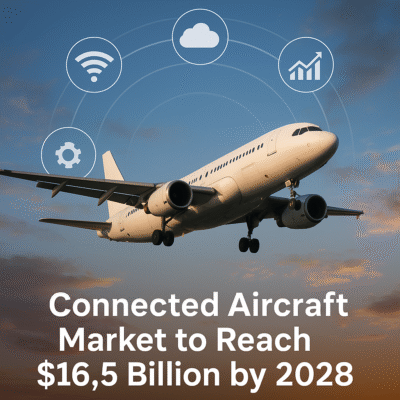The skies are getting smarter. A digital revolution is unfolding above us, with connected aircraft at the heart of aviation’s transformation. Projected to reach $16.5 billion by 2028, this market is redefining how we fly, operate, and experience air travel. A smart aircraft is more than a flying machine — it’s a data hub in motion.

What Is a Connected Aircraft?
A connected aircraft integrates advanced communication technologies to transmit data between the aircraft, ground systems, and satellite networks in real-time. This ecosystem enables continuous information flow across various stakeholders — pilots, air traffic control, maintenance teams, and even passengers.
Key connectivity systems include:
Satellite Communications (SATCOM)
*Air-to-ground connectivity
*Internet of Things (IoT) sensors
*AI and data analytics platforms
*Flight and crew management systems
Market Growth Drivers
The growth of connected aircraft is not just about faster Wi-Fi — it’s about building a smart aviation ecosystem where every aircraft becomes a real-time decision-making node. Several factors are contributing to this market’s impressive CAGR:
1. Demand for Real-Time Operational Efficiency
Airlines are increasingly leveraging real-time data from engines, avionics, and environmental sensors to optimize fuel efficiency, reduce turnaround times, and minimize delays.
2. Enhanced Passenger Experience
Wi-Fi at 35,000 feet is now expected. Passengers want uninterrupted connectivity for work, entertainment, and communication, driving demand for better bandwidth and seamless onboard services.
3. Predictive Maintenance & Safety
Connected aircraft enable predictive maintenance by continuously transmitting engine health data and system diagnostics, allowing ground teams to preemptively address issues. This not only enhances safety but also reduces aircraft downtime.
4. Regulatory Push & Government Initiatives
Aviation authorities globally are encouraging digital modernization and better surveillance capabilities, particularly in remote regions. Programs like the FAA’s NextGen and Europe’s SESAR are accelerating connectivity adoption.
5. Defense and Military Applications
The defense sector’s need for secure, high-speed airborne communication systems is also fueling the growth of connected aircraft technologies.
Key Technologies Powering the Shift-
*SATCOM High-speed, global connectivity across transoceanic and remote flights
*AI & Machine Learning Predictive maintenance, fuel optimization, decision support
*IoT Sensors Real-time tracking of aircraft systems and environmental conditions
*5G & Edge Computing Faster data processing for high-throughput aircraft systems
*Blockchain Secure, tamper-proof aircraft maintenance and parts tracking
Market Outlook by 2028
North America remains the largest market due to early adoption and strong aviation infrastructure.
Asia-Pacific is emerging as the fastest-growing region, led by rising air travel demand, fleet modernization, and smart airport investments.
Commercial aviation dominates the market share, but business jets and defense aviation are rapidly catching up.
Top Players in the Market
*Honeywell Aerospace
*Collins Aerospace (Raytheon Technologies)
*Panasonic Avionics
*Thales Group
*Gogo Inc.
*Inmarsat
*Viasat
*SITAONAIR
These companies are not just vendors but partners in digital transformation, offering hardware, software, and integrated connectivity platforms.
Challenges Ahead
Despite the optimistic forecast, the industry faces challenges such as:
High implementation costs, especially for older fleets
Cybersecurity risks due to increased digital exposure
Bandwidth limitations in congested air routes
Regulatory and standardization hurdles across regions
Addressing these challenges will require collaboration among OEMs, airlines, regulators, and tech providers.
The Future: Toward a Fully Digital Sky
The connected aircraft market is a cornerstone of the smart aviation ecosystem. As autonomous flight operations, unmanned aerial systems, and urban air mobility evolve, real-time connectivity will become even more critical. As connected aircraft evolve, we move closer to a world where the sky itself becomes a smart, responsive, data-driven environment. The future of aviation isn’t just airborne — it’s intelligent.
Airlines that invest today in digital infrastructure are not just improving operational efficiency — they are future-proofing their business models.
✈️ Final Thoughts
The connected aircraft market is no longer just about providing inflight Wi-Fi — it’s about enabling intelligent, autonomous, and responsive aviation. With a forecasted market value of $16.5 billion by 2028, we are entering an era where every aircraft is a data center in the sky, fundamentally changing how we fly, operate, and experience air travel.
Stay with us as we explore the technologies that are making our skies smarter — one aircraft at a time. Subscribe for more aviation tech insights.